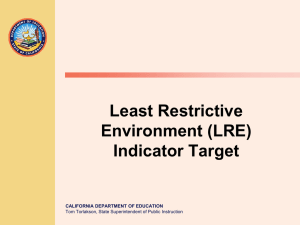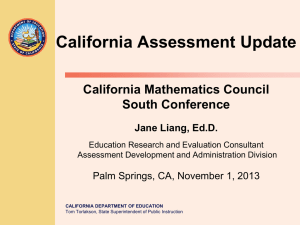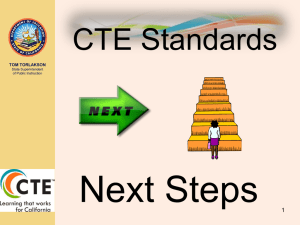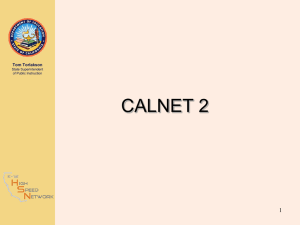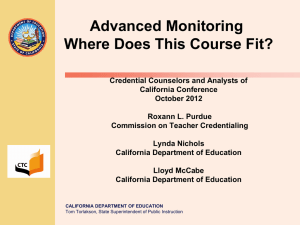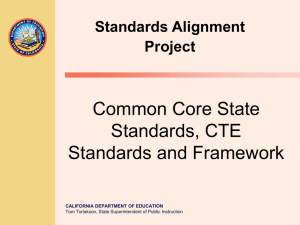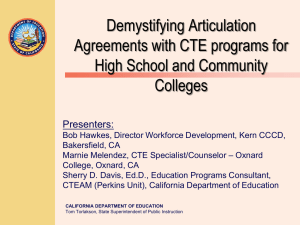PowerPoint Template - Forms (CDE Intranet)
advertisement
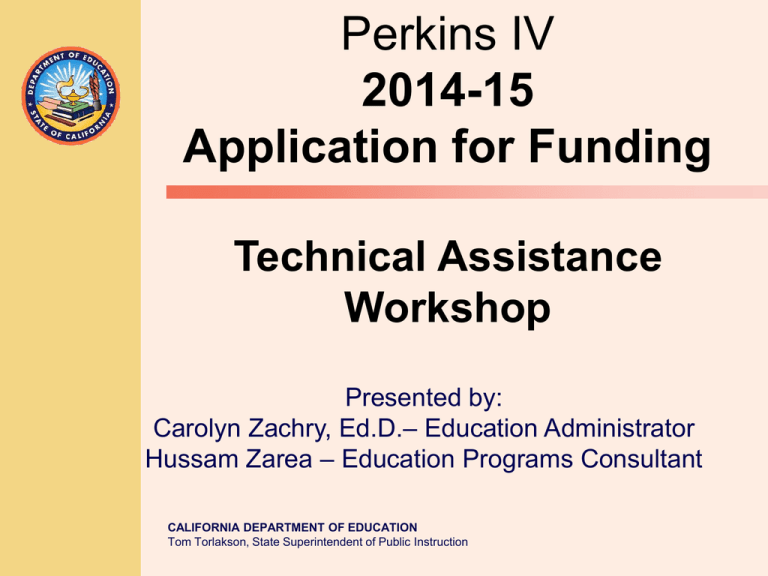
Perkins IV 2014-15 Application for Funding Technical Assistance Workshop Presented by: Carolyn Zachry, Ed.D.– Education Administrator Hussam Zarea – Education Programs Consultant CALIFORNIA DEPARTMENT OF EDUCATION Tom Torlakson, State Superintendent of Public Instruction Workshop Objectives: TOM TORLAKSON State Superintendent of Public Instruction 1. Review Perkins IV funding requirements. 2. Updates on State CTE issues 3. What to expect in Perkins V 4. Review the 2014–2015 online Perkins Grant Management System TOM TORLAKSON State Superintendent of Public Instruction General Information and Eligibility Requirements TOM TORLAKSON State Superintendent of Public Instruction Carl D. Perkins Career and Technical Education Improvement Act of 2006 Public Law 109-270 (Perkins IV) • Signed into law on August 12, 2006. • Authorizes federal funding assistance to secondary and postsecondary career technical education (CTE) programs. TOM TORLAKSON State Superintendent of Public Instruction • Requires every state and local educational agency (LEA) that receives Perkins funding to have a Five-Year CTE Plan. California’s State Plan is posted at the following outside sources: www.wested.org/cteplan or http://www.cteonline.org/ctestateplan/. Background Information TOM TORLAKSON State Superintendent of Public Instruction • The 2008-2012 California State Plan for Career Technical Education (State Plan) should be referenced in conjunction with the Perkins IV Act when determining how funds can be spent. • Chapters 3 and 5 of the State Plan are critical to LEAs. Grant Information TOM TORLAKSON State Superintendent of Public Instruction The application covers the grant period July 1, 2014–June 30, 2015. The amount of Perkins IV funds available to each LEA for 2014–15 will be posted on the CDE Web site at http://www.cde.ca.gov/fg/fo/r17/perkins12result.asp Eligibility Requirements TOM TORLAKSON State Superintendent of Public Instruction • Only public secondary and postsecondary LEAs may receive Perkins IV funds. • An LEA must demonstrate that it conducts one or more CTE programs and that each program assisted with Perkins IV funds complies with the requirements in Perkins IV Section 135(b) and Chapter Five of the State Plan. Perkins IV Act Title I, Part C, Sections 131(secondary) and 132 (postsecondary) Eligibility Requirements (continued) TOM TORLAKSON State Superintendent of Public Instruction • Perkins IV grant applicants must have an approved local CTE plan on file with the CDE. • An LEA that does not have a local CTE plan on file with the CDE may complete a CTE plan and submit it with the application in order to receive 2014–15 funding. Eligibility Requirements (continued) TOM TORLAKSON State Superintendent of Public Instruction Perkins funds are available to: • Secondary LEAs, Grades seven through twelve (Section 131), and • Postsecondary LEAs (Section 132) Secondary LEAs (Section 131) TOM TORLAKSON State Superintendent of Public Instruction • Include union high or unified school districts; public charter schools; county offices of education. • Minimum grant allocation is $15,000 • If an LEA’s allocation does not equal $15,000: o o Enter into a consortium Apply for a waiver if: • Located in a rural, sparsely-populated area, and; • Can demonstrate inability to enter into a consortium. How are Section 131 (Secondary) Allocations Determined? TOM TORLAKSON State Superintendent of Public Instruction – 30 percent is based on an LEA’s proportion of the State’s kindergarten through grade twelve (K-12) enrollment – 70 percent is based on LEA’s proportion of the State’s K-12 enrollment of students from homes with incomes below the poverty level Postsecondary LEAs (Section 132) TOM TORLAKSON State Superintendent of Public Instruction • Include community college districts, CTE programs for adults conducted by unified or union high school districts, and Regional Occupational Centers or Programs (ROCPs) serving adults • Minimum grant $50,000 • If LEA’s allocation does not equal $50,000: o o Must join a consortium No waivers TOM TORLAKSON How are Section 132 (Postsecondary) Allocations Determined? State Superintendent of Public Instruction – Based entirely on the number of economically disadvantaged adults enrolled in CTE programs during the previous program year – CDE 20 and comparison to data submitted on E-1 Program and Administrative Requirements TOM TORLAKSON State Superintendent of Public Instruction Perkins IV and Chapter 5 of the State Plan establish the requirements and policies for: • local administration of Perkins funds, • the appropriate use of Perkins funds, and • the secondary and postsecondary CTE programs that will be assisted with Perkins funds. Use of Perkins IV Funds TOM TORLAKSON State Superintendent of Public Instruction No less than 85 percent of the LEA’s allocation must be spent to improve or expand CTE programs and courses approved in the local plan and annual application for funds. 85 percent goes to the classroom Use of Perkins IV Funds (continued) TOM TORLAKSON State Superintendent of Public Instruction Up to 10 percent may be expended to provide other activities that support CTE and may not be occurring directly in the classroom. Use of Perkins IV Funds (continued) TOM TORLAKSON State Superintendent of Public Instruction Up to 5 percent may be charged for direct or indirect costs for expenditures incurred in activities required to administer the grant. Perkins funds for administration (personnel salaries) cannot exceed 5 percent TOM TORLAKSON State Superintendent of Public Instruction On p. 221, 222 of the State Plan (http://www.schoolsmovingup.net/cte/downloads/c teplan_ch5_122808.pdf), the policy states “No less than 85 percent of the LEA’s Section 131 or 132 allocation must be expended to improve or expand….”. It goes on to state: “Up to 5 percent of the allocation may be charged to direct or indirect costs for expenditures incurred in activities required to administer the grant. Up to 10 percent of the allocation may be expended to support other CTE activities that are consistent with the purpose of the Act”. The long standing policy has been that Indirect can only be claimed based on the actual expenditures. CTE Program Requirements TOM TORLAKSON State Superintendent of Public Instruction CTE programs assisted with Perkins IV funds must incorporate planning, organization, and instructional elements determined by the state to be critical to high-quality CTE programs. Each CTE program receiving Perkins IV funds must have the following components: CTE Program Requirements (continued) TOM TORLAKSON State Superintendent of Public Instruction 1. A sequence of courses that provides students with coherent and rigorous content aligned with challenging academic standards and relevant technical knowledge and skills. CTE Program Requirements (continued) TOM TORLAKSON State Superintendent of Public Instruction 2. Be staffed by qualified CTE teachers who a) possess a standard secondary, singlesubject or designated-subject credential which authorizes the teaching of the CTE course(s) to which assigned, and b) can document employment experience, outside of education, in the career pathway addressed by the program or other evidence of equivalent proficiency. CTE Program Requirements (continued) TOM TORLAKSON State Superintendent of Public Instruction 3. Focus on current or emerging high skill, high wage, or high demand occupations. 4. Be aligned with the state’s CTE Model Curriculum Standards and Framework. CTE Program Requirements (continued) TOM TORLAKSON State Superintendent of Public Instruction 5. Have extensive business and industry involvement, as evidenced by at least one business and industry advisory committee meeting annually, and planned business and industry involvement in program activities. CTE Program Requirements (continued) TOM TORLAKSON State Superintendent of Public Instruction 6. Provide for certification of students who achieve industry-recognized skill and knowledge requirements. 7. Be aligned with applicable feeder and advanced-level instruction in the same career pathway. CTE Program Requirements (continued) TOM TORLAKSON State Superintendent of Public Instruction 8. Integrate the development of CTE and academic skills in order to prepare students for immediate employment upon graduation and for further education or training. 9. Provide practical applications and experiences through actual or simulated work-based learning assignments. CTE Program Requirements (continued) TOM TORLAKSON State Superintendent of Public Instruction 10. Provide for equitable access and needed support services of all students, including special populations and those preparing for nontraditional occupations. CTE Program Requirements (continued) TOM TORLAKSON State Superintendent of Public Instruction 11. Include planned career awareness and exploration experiences. CTE Program Requirements (continued) TOM TORLAKSON State Superintendent of Public Instruction 12. Provide for the development of student leadership skills through an established career technical student organization or an alternate strategy that incorporates this instruction in all of the courses that make up the sequence. CTE Program Requirements (continued) TOM TORLAKSON State Superintendent of Public Instruction 13. Use annual evaluation results, including achieved core indicator performance levels, to determine needed program improvements, modifications, and professional development activities for staff. CTE Program Requirements (continued) TOM TORLAKSON State Superintendent of Public Instruction 14. Have a systematic plan for promoting the program to all concerned groups, including, but not limited to, students, parents, counselors, site and district administrators, and postsecondary educational agencies. Requirements of Sequences of Courses for CTE Programs TOM TORLAKSON State Superintendent of Public Instruction Requirements of Sequences of Courses for CTE Programs (continued) TOM TORLAKSON State Superintendent of Public Instruction • Consist of not less than two full-year CTE courses with a combined duration of not less than 300 hours; • or a single, multiple-hour course which provides sequential units of instruction and has a duration of not less than 300 hours. Requirements of Sequences of Courses for CTE Programs (continued) TOM TORLAKSON State Superintendent of Public Instruction • Be coherent: the sequence may only include CTE courses with objectives and content that have a clear and direct relationship to the occupation(s) or careers targeted by the program. Requirements of Sequences of Courses for CTE Programs (continued) TOM TORLAKSON State Superintendent of Public Instruction • Include introductory and concentration CTE courses to develop the skill and knowledge required for employment and postsecondary education or training. Requirements of Courses Assisted with Perkins IV Funds TOM TORLAKSON State Superintendent of Public Instruction • Be integral to an approved CTE sequence of courses. • Be explicitly designed to prepare students with career skills that lead to employment. (Employment could be at the completion of high school, community college, apprenticeship, or four-year college or university.) Requirements of Courses Assisted with Perkins IV Funds (continued) TOM TORLAKSON State Superintendent of Public Instruction • Have no less than 50 percent of course curriculum and content directly related to the development of career knowledge and skills. • Have business and industry involvement in the development and validation of the curriculum. • Be taught by a teacher who meets the CTE teacher credential and occupational experience qualifications. Program of Study Requirement TOM TORLAKSON State Superintendent of Public Instruction • As mandated by Section 122(c)(1)(A) of Perkins IV, each LEA receiving Section 131 or 132 funds must have at least one program of study in place to receive Perkins IV funds. • The Program of Study must have been included in the Local CTE Plan. Middle School Participation in the Perkins IV Funds TOM TORLAKSON State Superintendent of Public Instruction • Middle school (grades seven and eight) CTE courses may be assisted with Section 131 (secondary) funds only if the courses directly lead to an approved sequences of courses conducted by a high school. ROCP Participation in the Perkins IV Section 131 Funds TOM TORLAKSON State Superintendent of Public Instruction • ROCPs may receive funds directed to county offices of education (COE). • Section 131 allocations to COEs will no longer be restricted to court and community school use. ROCP Participation in the Perkins IV Section 131 Funds (continued) TOM TORLAKSON State Superintendent of Public Instruction • Some or all of a COE allocation could be used for ROCP program improvements, which could include programs for court and community school students. ROCP Participation in the Perkins IV Section 131 Funds TOM TORLAKSON State Superintendent of Public Instruction • Districts may choose to direct their allocated funds to a consortium which has an ROCP as the fiscal agent. • An ROCP may also become an eligible recipient of Section 131 funds if one or more districts determine the following: ROCP Participation in the Perkins IV Section 131 Funds (continued) TOM TORLAKSON State Superintendent of Public Instruction • its allocation is insufficient to warrant the required administrative activities, • or it is not providing at least one districtfunded CTE course, and • it chooses to transfer funds to the ROCP. In these instances, the ROCP may form a consortium with the district(s) in order to receive the Section 131 funds. ROCP Participation in the Perkins IV Section 131 Funds TOM TORLAKSON State Superintendent of Public Instruction • ROCP courses that are integral to coherent sequences of courses conducted by LEAs that receive Section 131 funds (unified and union high school districts) may be assisted with the funds allocated to their member LEAs. Local Funds Required in District Programs TOM TORLAKSON State Superintendent of Public Instruction As a condition of receiving Section 131 funds, the LEA must be actively involved in the delivery of CTE programs. The LEA must • provide at least one CTE sequence of courses that includes at least one district-funded course. • provide at least one course in each industry sector assisted with the Perkins funds. Consortium Allocations TOM TORLAKSON State Superintendent of Public Instruction • Section 131 and 132 consortium funds may not be redistributed to individual members for purposes or programs that benefit only one member. No pass through! Consortium Allocations (continued) TOM TORLAKSON State Superintendent of Public Instruction • Funds allocated to a consortium formed to meet the minimum allocation requirement may be used only for purposes and programs that are mutually beneficial to all members of the consortium. Use Funds to Support Work Experience Education TOM TORLAKSON State Superintendent of Public Instruction Section 131 and 132 funds may not be used to assist General Work Experience Education. Work Experience Education activities may be assisted with Section 131 and 132 funds if: • they are a planned and listed component of a CTE program, • are integral to one or more of the approved sequences of courses in the LEA’s local plan and annual application for funds, and • comply with applicable State and federal regulations. Assurances, Certifications, Terms, and Conditions TOM TORLAKSON State Superintendent of Public Instruction • Federal and state assurances and certifications no longer must be returned to the CDE. • The grant application’s signed cover page commits the LEA to comply with the assurances, certifications, terms, and conditions. Assurances, Certifications, Terms, and Conditions (continued) TOM TORLAKSON State Superintendent of Public Instruction • Assurances, certifications, grant terms and conditions should be kept on file for audits, compliance reviews, or complaint investigations. Application Review Process TOM TORLAKSON State Superintendent of Public Instruction • The review of all applications will occur during May and June, with final approval by June 30. • Each application will be read by the CDE consultant responsible for the region within which the LEA is located. Application Review Process (continued) TOM TORLAKSON State Superintendent of Public Instruction • If additional information or revisions are needed in order to approve the application, the LEA will have the opportunity to provide the necessary information. TOM TORLAKSON State Superintendent of Public Instruction Payment Procedures and Timeline TOM TORLAKSON State Superintendent of Public Instruction Perkins IV funds are provided to LEAs on a reimbursement basis only. Why? Payment Procedures TOM TORLAKSON State Superintendent of Public Instruction • U.S. Education Department General Administrative Regulations (EDGAR) states that federal funds must be spent within 72 hours of receipt at the local level. • Since that is unlikely to happen in California; the CDE reimburses LEAs for approved CTE expenditures. Payment Timeline TOM TORLAKSON State Superintendent of Public Instruction Quarterly claims for reimbursements may be submitted four times a year, preferably before the deadline date. Grant Quarter Months in which Expenditures Occurred Deadline to Submit VE-5 First July, August, September October 31 Second October, November, December January 31 Third January, February, March April 30 Final April, May, June September 30 Payment Timeline (continued) TOM TORLAKSON State Superintendent of Public Instruction Filing of a Second Quarter, mid-year, claim in January is MANDATORY. Grant Quarter Months in which Expenditures Occurred Deadline to Submit VE-5 First July, August, September October 31 Second October, November, December January 31 Third January, February, March April 30 Final April, May, June September 30 Payment Timeline (continued) TOM TORLAKSON State Superintendent of Public Instruction • All funds must be expended or legally obligated by: June 30, 2012. • Any funds left unclaimed after September 30, 2014 will revert to the CDE for reallocation to other LEAs in 2015-16. TOM TORLAKSON State Superintendent of Public Instruction State and Federal CTE Issues • Maintenance of Effort – Using Goal Code 3800 TOM TORLAKSON State Superintendent of Public Instruction • Budget – Federal Sequestration – State budget (LCFF) • Perkins V Perkins V TOM TORLAKSON State Superintendent of Public Instruction • Current Perkins IV legislation provides funds through fiscal year 2012.(School year 2014–15) • Perkins IV will continue until congress takes action • Just beginning discussions in Washington Perkins V TOM TORLAKSON State Superintendent of Public Instruction • • • Emphasis on well-articulated pathways to college and employment Raise the level and quality of public and private partnerships Cultivate innovation, entrepreneurship, and leadership Perkins V TOM TORLAKSON State Superintendent of Public Instruction • • • Overhaul the accountability system by creating uniform participation and performance measures Create a stronger, more-effective evidence base for CTE Enhance supports for teachers and for students/parents by ensuring they have career information and counseling supports to make better decisions Perkins V TOM TORLAKSON State Superintendent of Public Instruction • • • Funding to consortia only Funding only Programs of Study leading to a degree, certificate, or license Support the identification, development, testing and scale up of promising new practices and delivery systems Perkins V TOM TORLAKSON State Superintendent of Public Instruction • • Revised accountability system based on uniformly defined participation and performance measures, as well as a better-structured system of rewards and consequences for performance Proposal would support programs that are better aligned with the needs of employers and industry E1/E2 and CALPADS TOM TORLAKSON State Superintendent of Public Instruction • With CALPADS implementing – All CTE students are Participants • CTE Students from Courses numbered 4000 or 5000 – Issue • What if “CTE” class isn’t in 4000 or 5000 TOM TORLAKSON State Superintendent of Public Instruction – Example » Biology (2603) or Ag Biology (4073) » Forensics (2115) or Forensic Science (5840) » Computer Literacy (2450) or Digital Lit (4632) » Web Design (2455) or Essential Web Skills (4605) » Computer Sci / Programming (2470) or Computer Programming/Game Design (4616) • Only students from 4000 or 5000 will be counted as CTE students TOM TORLAKSON State Superintendent of Public Instruction • CTE Concentrators will be identified by Pathway – A concentrator is 50% completed with a pathway and in the next course – CTE Concentrators will have a 3 digit pathway code assigned in their student record and indicate if they “complete” the pathway. • Ex – AgScience Concentrators need to be id with pathway 103 – Welding Concentrators will be id with pathway 213 – Programming Concentrators will be id with pathway 173 • CTE info is collected in the End Of Year Collection. TOM TORLAKSON State Superintendent of Public Instruction – Along with AP/IB courses, CTE Concentrator info will be considered in Career/College Readiness portion of API • Info can be found in Code Sets file at: http://www.cde.ca.gov/ds/sp/cl/doc uments/codesets110413.xls TOM TORLAKSON State Superintendent of Public Instruction Instructions for Submitting the Perkins IV Application Perkins Grant Management System TOM TORLAKSON State Superintendent of Public Instruction • The CDE is accepting online applications only • Same user ID and password • The system will lock on: Thursday, May 1, 2014 at midnight TOM TORLAKSON State Superintendent of Public Instruction If there are questions about completing the Perkins IV 2014–15 Application for Funding, contact the CDE consultant responsible for your grant. For More Information Perkins Web page: www.cde.ca.gov/ci/ct/pk Main Phone number PAS Office: 916-324-5706 Perkins E-mail Address: perkins@cde.ca.gov CALIFORNIA DEPARTMENT OF EDUCATION Tom Torlakson, State Superintendent of Public Instruction TOM TORLAKSON State Superintendent of Public Instruction Thank You

